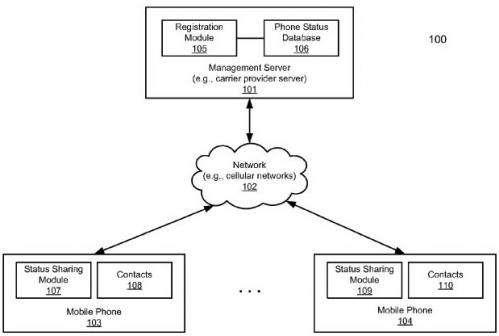Credit: USPTO
(Phys.org) —An Apple iPhone invention would allow you to check the availability status of another iPhone user before you make the phone call. The advantage for the caller would be avoiding being dumped into voice mail without knowing when it would be a good time to call. The invention is not something available to Apple users; it is only a patent filing, which was published Thursday by the US Patent and Trademark Office. The application was originally filed in February 2012. Inventors are named as Devrim Varoglu and Swapnil Dave. The patent title is "Methods to Determine Availability of User Based on Mobile Phone Status." The status information might include more information than whether the person is free to take the call: Remaining battery life, time zone, current location, strength of the callee's signal (if it is indicated that the remote mobile phone is in an area that does not have a good reception, the local user may decide not to call) and whether the callee is in some special mode—normal, vibrate, airplane.
According to the patent, "if the remote mobile phone is operating in a vibration mode, a user of the local mobile phone may interpret that the user of the second mobile phone does not want to be called upon. In this example, the local user may defer calling or send an email or a text instead."
Apple's patent would reduce uncertainty of how likely the callee would be able to return a call quickly, and the caller could decide, after viewing the status on screen, whether to complete the call or to use another communication mode such as email.
On the callee's side, the advantage might be a way to avoid rings that can interrupt an office meeting, or any other event.
How it works: The iPhone owner sets preferences and user sharing policies on the iPhone, which then reports to the server at preset intervals. As such, the phone automatically reports the operating status and conditions to a server; the process is taking place in the background. On the caller's side, the device would display the contact's operating status data automatically.
The patent makes note of why this would be advantageous as compared with conventional caller ID.
"Caller ID service is conventionally available to provide a callee with limited information about a call for call screening purposes, with the callee usually having very few options to manage the call. In particular, for most callees, the only available actions are to accept the call or decline it by either not answering or allowing an answering machine or voice mail system to respond. The caller in such cases has no control over whether or not the call will be accepted.
"More advanced Caller ID services can provide the callee with limited interaction with the caller to assist the call screening process, thereby giving both the caller and the callee more control over the call. However, despite the limited interaction, the caller still has no effective way of knowing when the callee is willing to accept their call."
More information: Patent
via AppleInsider
© 2013 Phys.org





















